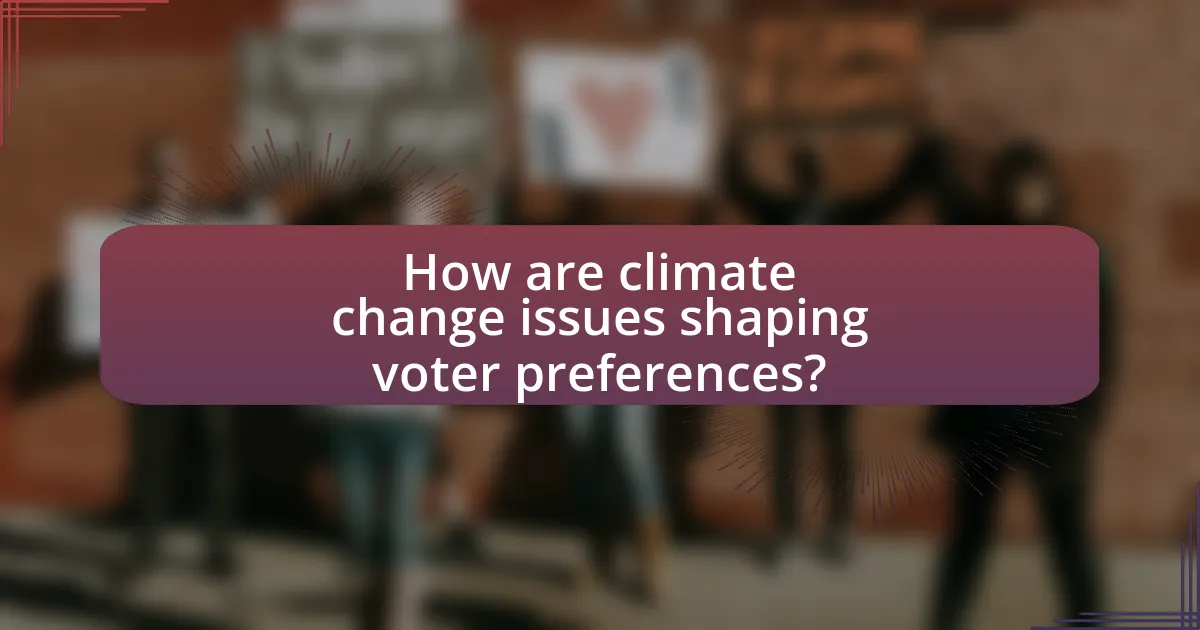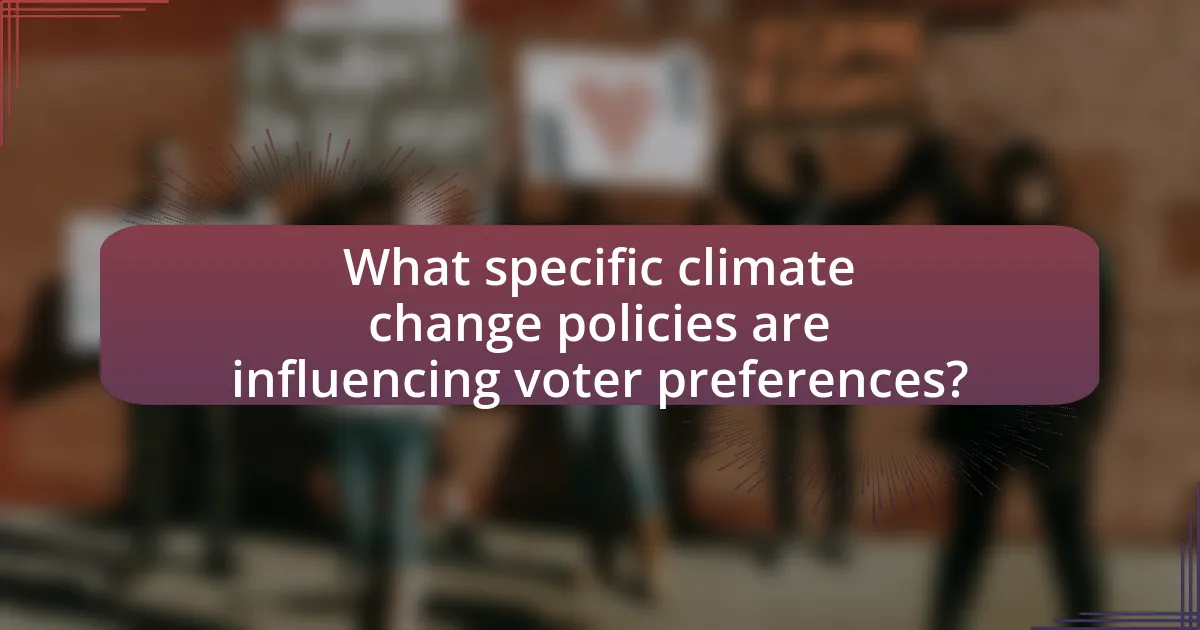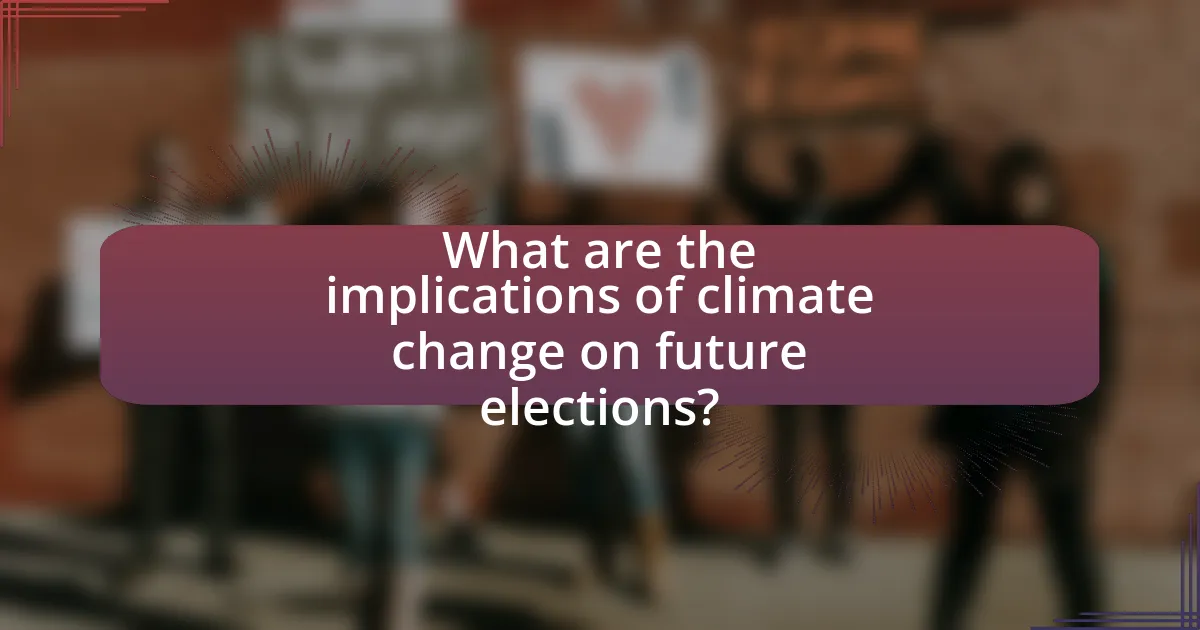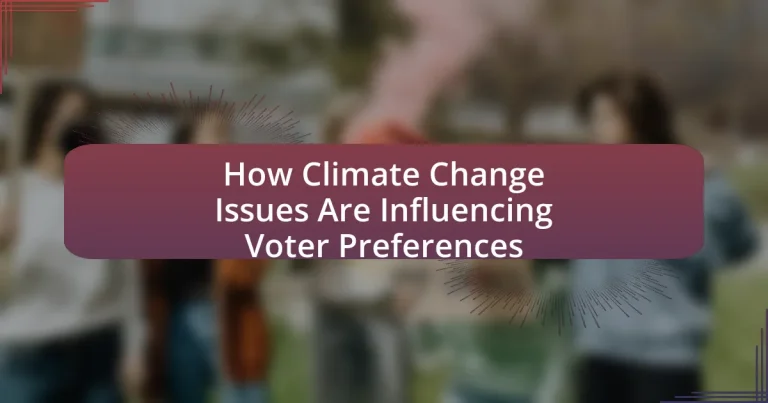The article examines how climate change issues are shaping voter preferences and influencing political decision-making. It highlights that a significant majority of voters, particularly younger demographics, prioritize climate action in their electoral choices, with surveys indicating that around 70% view climate change as a major threat. Key factors influencing voter opinions include extreme weather events, economic impacts, and environmental degradation, which drive support for candidates advocating for strong climate policies. The article also discusses the role of political parties in addressing climate change, the impact of grassroots movements, and the implications for future elections as public concern over climate issues continues to rise.

How are climate change issues shaping voter preferences?
Climate change issues are significantly shaping voter preferences by increasing the importance of environmental policies in electoral decisions. A 2020 Pew Research Center survey indicated that 67% of voters considered climate change a major threat, influencing their support for candidates who prioritize sustainability and climate action. Additionally, younger voters, particularly those aged 18-29, are more likely to support candidates with strong environmental platforms, as evidenced by a 2021 study from the Harvard Kennedy School, which found that 63% of this demographic prioritized climate change in their voting decisions. This trend demonstrates that climate change is becoming a pivotal factor in shaping electoral outcomes and party platforms.
What role does climate change play in political decision-making?
Climate change significantly influences political decision-making by shaping policy priorities and voter preferences. Politicians often respond to public concern about climate change by advocating for environmental policies, which can sway electoral outcomes. For instance, a 2020 study by the Yale Program on Climate Change Communication found that 70% of Americans support government action on climate change, indicating that political leaders who prioritize this issue may gain voter support. Additionally, climate-related events, such as hurricanes and wildfires, can catalyze immediate political responses, prompting lawmakers to implement or enhance climate policies. This demonstrates that climate change is not only a scientific issue but also a critical factor in shaping political agendas and electoral strategies.
How do voters perceive the urgency of climate change?
Voters perceive the urgency of climate change as high, with a significant majority expressing concern over its impacts. According to a 2021 Pew Research Center survey, 70% of Americans view climate change as a major threat, indicating a strong sense of urgency among the electorate. This perception influences voter preferences, as candidates prioritizing climate action tend to receive greater support, reflecting the electorate’s demand for immediate and effective responses to environmental challenges.
What are the key climate change issues influencing voter opinions?
Key climate change issues influencing voter opinions include extreme weather events, economic impacts, and environmental degradation. Extreme weather events, such as hurricanes and wildfires, have increased in frequency and intensity, leading voters to prioritize climate action. Economic impacts, including job losses in traditional energy sectors and the rising costs of climate-related disasters, also shape voter preferences, as individuals seek policies that promote sustainable job creation. Additionally, environmental degradation, such as air and water pollution, raises public concern, prompting voters to support candidates advocating for stronger environmental protections. These issues are supported by data indicating that a significant portion of the electorate views climate change as a critical issue, with polls showing that around 70% of voters consider it a priority in elections.
Why are younger voters more concerned about climate change?
Younger voters are more concerned about climate change due to their heightened awareness of its long-term impacts on their future. Research indicates that 75% of millennials and Gen Z individuals view climate change as a significant threat, reflecting their understanding that environmental degradation will directly affect their lives, economies, and health. This demographic has grown up amidst increasing climate-related disasters and scientific reports emphasizing the urgency of action, such as the Intergovernmental Panel on Climate Change’s findings that highlight the need for immediate measures to limit global warming. Consequently, younger voters prioritize climate policies in their voting decisions, seeking candidates who advocate for sustainable practices and environmental justice.
What specific climate policies resonate with younger demographics?
Specific climate policies that resonate with younger demographics include aggressive carbon reduction targets, investment in renewable energy, and the promotion of sustainable transportation options. Younger voters prioritize policies that aim for net-zero emissions by 2050, as evidenced by a 2021 survey from the Pew Research Center, which found that 75% of individuals aged 18-29 support stronger government action on climate change. Additionally, policies that enhance access to electric vehicles and public transit are favored, reflecting a desire for sustainable mobility solutions. The emphasis on climate justice and equitable transitions also aligns with younger voters’ values, as highlighted in a 2020 report by the Sunrise Movement, which underscores the importance of addressing social inequalities within climate action.
How does climate change awareness differ across age groups?
Climate change awareness significantly differs across age groups, with younger individuals generally exhibiting higher levels of concern and engagement compared to older generations. Research indicates that 70% of millennials and Gen Z express a strong belief in the urgency of climate action, while only about 50% of baby boomers share this sentiment. This disparity is often attributed to younger people’s greater exposure to climate education and media coverage, as well as their reliance on social media platforms that emphasize environmental issues. Additionally, surveys show that younger voters are more likely to prioritize climate change in their voting decisions, influencing political agendas and party platforms.
How do political parties address climate change in their platforms?
Political parties address climate change in their platforms by incorporating specific policies aimed at reducing greenhouse gas emissions, promoting renewable energy, and enhancing climate resilience. For instance, many parties advocate for commitments to achieve net-zero emissions by a certain year, often citing scientific consensus on the need for urgent action to mitigate climate impacts. The Democratic Party in the United States, for example, emphasizes the Green New Deal, which includes investments in clean energy and infrastructure to combat climate change. Similarly, the European Green Party prioritizes environmental sustainability in its platform, advocating for ambitious climate targets aligned with the Paris Agreement. These positions reflect a growing recognition among political parties that climate change is a critical issue influencing voter preferences, as evidenced by polling data showing that a significant portion of the electorate prioritizes climate action in their voting decisions.
What strategies do parties use to appeal to climate-conscious voters?
Parties appeal to climate-conscious voters by prioritizing environmental policies, promoting renewable energy initiatives, and committing to carbon reduction targets. For instance, many political parties advocate for legislation that supports the transition to renewable energy sources, such as wind and solar power, which aligns with the values of climate-conscious constituents. Additionally, parties often emphasize their commitment to international climate agreements, such as the Paris Agreement, to demonstrate their dedication to global climate action. Research indicates that voters increasingly favor candidates who present clear, actionable plans for addressing climate change, reflecting a significant shift in voter preferences towards sustainability and environmental responsibility.
How do party affiliations influence views on climate change?
Party affiliations significantly influence views on climate change, with Democrats generally expressing greater concern and support for climate action compared to Republicans. Research indicates that approximately 85% of Democrats believe climate change is a serious problem, while only about 50% of Republicans share this view, according to a 2021 Pew Research Center survey. This divergence is often attributed to differing ideological beliefs, where Democrats typically prioritize environmental issues and advocate for regulatory measures, whereas Republicans may emphasize economic growth and skepticism towards government intervention.
What connections exist between climate change and voter turnout?
Climate change significantly influences voter turnout, as individuals increasingly prioritize environmental issues in their voting decisions. Research indicates that extreme weather events, such as hurricanes and wildfires, can mobilize voters, particularly in regions directly affected, leading to higher participation rates in elections. For instance, a study by the Yale Program on Climate Change Communication found that 70% of Americans are more likely to vote for candidates who prioritize climate action, demonstrating a direct correlation between climate awareness and electoral engagement. Additionally, younger voters, who are more concerned about climate change, tend to have higher turnout rates when environmental issues are prominent in campaigns. This connection underscores the impact of climate change on voter behavior and electoral outcomes.
How do climate change issues impact election outcomes?
Climate change issues significantly impact election outcomes by influencing voter preferences and party alignment. Research indicates that voters increasingly prioritize climate policies, with polls showing that a majority of Americans view climate change as a critical issue affecting their voting decisions. For instance, a 2020 Pew Research Center survey found that 67% of registered voters considered climate change a major threat, leading candidates who advocate for strong environmental policies to gain support. Additionally, in the 2020 U.S. presidential election, areas severely affected by climate-related disasters, such as wildfires and hurricanes, showed shifts in voter behavior, often favoring candidates with robust climate action plans. This trend illustrates that climate change not only shapes individual voter priorities but also influences broader electoral dynamics and party strategies.

What specific climate change policies are influencing voter preferences?
Specific climate change policies influencing voter preferences include carbon pricing, renewable energy incentives, and emissions reduction targets. Carbon pricing mechanisms, such as cap-and-trade systems, have been shown to garner support among voters who prioritize environmental sustainability, as they directly link economic costs to carbon emissions. Renewable energy incentives, like tax credits for solar and wind energy, appeal to voters seeking job creation in green industries and energy independence. Additionally, ambitious emissions reduction targets, such as those outlined in the Paris Agreement, resonate with younger voters who are increasingly concerned about climate impacts on their future. Research indicates that 70% of voters support policies aimed at reducing greenhouse gas emissions, highlighting the significant influence of these policies on electoral outcomes.
Which climate policies are most popular among voters?
The climate policies most popular among voters include renewable energy incentives, carbon pricing, and regulations on greenhouse gas emissions. Surveys indicate that a significant majority of voters support policies that promote clean energy sources, with approximately 70% favoring government incentives for solar and wind energy development. Additionally, carbon pricing mechanisms, such as cap-and-trade systems, receive support from around 60% of the electorate, as they are seen as effective tools for reducing emissions. Furthermore, regulations aimed at limiting greenhouse gas emissions from industries and vehicles are backed by over 65% of voters, reflecting a strong public demand for action on climate change.
How do renewable energy initiatives affect voter support?
Renewable energy initiatives positively affect voter support by aligning with public concern over climate change and environmental sustainability. Research indicates that voters are increasingly prioritizing candidates and policies that promote clean energy solutions, with a 2021 survey by the Pew Research Center showing that 79% of Americans support expanding solar panel farms and wind turbine installations. This support translates into higher approval ratings for political figures advocating for renewable energy policies, as evidenced by election outcomes in regions that have embraced such initiatives.
What is the public opinion on carbon pricing and taxes?
Public opinion on carbon pricing and taxes is generally supportive, with a significant portion of the population recognizing their potential to mitigate climate change. According to a 2021 survey by the Yale Program on Climate Change Communication, approximately 70% of Americans favor a carbon tax, especially if the revenue is used for renewable energy initiatives or to reduce other taxes. This support is often influenced by concerns over climate change impacts, with many voters believing that carbon pricing can drive emissions reductions effectively.
How do local climate initiatives influence state and national elections?
Local climate initiatives significantly influence state and national elections by shaping voter priorities and mobilizing grassroots support. These initiatives often highlight the importance of environmental issues, prompting candidates to adopt climate-friendly policies to align with constituents’ values. For instance, in the 2020 U.S. elections, candidates who endorsed local climate initiatives, such as renewable energy projects and sustainability programs, gained traction among voters concerned about climate change, as evidenced by a survey from the Yale Program on Climate Change Communication, which found that 70% of Americans support government action on climate change. This alignment can sway election outcomes, as seen in various local elections where candidates advocating for climate action have successfully unseated incumbents who opposed such measures.
What examples exist of local policies swaying voter preferences?
Local policies addressing climate change have significantly swayed voter preferences in various regions. For instance, California’s implementation of aggressive greenhouse gas reduction targets and renewable energy mandates has garnered support from environmentally conscious voters, leading to increased backing for candidates who prioritize climate action. Additionally, New York City’s introduction of the Climate Mobilization Act, which mandates emissions reductions from large buildings, has influenced voter sentiment, as residents increasingly favor policies that promote sustainability and environmental responsibility. These examples illustrate how local climate policies can directly impact voter behavior and preferences in elections.
How do grassroots movements impact political campaigns?
Grassroots movements significantly impact political campaigns by mobilizing community support and influencing voter engagement. These movements often raise awareness about specific issues, such as climate change, which can shift public opinion and voter priorities. For instance, the Sunrise Movement has effectively galvanized young voters around climate action, leading to increased pressure on political candidates to adopt more progressive environmental policies. This grassroots activism can result in higher voter turnout and can sway undecided voters, as seen in the 2020 U.S. elections where climate change became a pivotal issue for many voters.

What are the implications of climate change on future elections?
Climate change significantly influences future elections by shaping voter preferences and priorities. As extreme weather events and environmental degradation become more prevalent, voters increasingly prioritize candidates and policies that address climate issues. For instance, a 2020 Pew Research Center survey indicated that 67% of Americans view climate change as a major threat, influencing their voting decisions. This shift in public opinion compels political parties to adopt more aggressive climate policies to attract and retain voters, thereby altering campaign strategies and electoral outcomes.
How might climate change shape future voter demographics?
Climate change is likely to shape future voter demographics by increasing the political engagement of younger generations who prioritize environmental issues. Research indicates that millennials and Generation Z are more likely to vote for candidates who advocate for climate action, reflecting a shift in voter priorities. For instance, a 2020 study by the Pew Research Center found that 67% of young voters consider climate change a major threat, compared to 45% of older voters. This generational divide suggests that as younger voters become a larger portion of the electorate, their preferences for climate-focused policies will significantly influence election outcomes and party platforms.
What trends are emerging in voter attitudes towards climate change?
Emerging trends in voter attitudes towards climate change indicate a significant increase in concern and urgency regarding environmental issues. Recent surveys show that a majority of voters, particularly younger demographics, prioritize climate action as a critical factor influencing their electoral decisions. For instance, a 2023 Pew Research Center study found that 70% of voters aged 18-29 view climate change as a major threat, reflecting a shift towards prioritizing sustainability in political platforms. Additionally, there is growing bipartisan support for climate policies, with 60% of voters across party lines favoring government action to address climate change, as reported by the Yale Program on Climate Change Communication. This trend suggests that climate change is becoming a pivotal issue in shaping voter preferences and electoral outcomes.
How could climate change influence the political landscape in the coming years?
Climate change could significantly influence the political landscape in the coming years by shifting voter priorities towards environmental policies and sustainability initiatives. As extreme weather events and climate-related disasters become more frequent, public concern over climate issues is likely to increase, prompting voters to favor candidates and parties that prioritize climate action. For instance, a 2021 survey by the Pew Research Center found that 70% of Americans view climate change as a major threat, indicating a strong public demand for political responsiveness to environmental issues. This shift in voter preferences may lead to the election of more progressive leaders who advocate for comprehensive climate policies, thereby reshaping legislative agendas and party platforms to focus on sustainability and climate resilience.
What strategies can candidates use to engage climate-conscious voters?
Candidates can engage climate-conscious voters by prioritizing clear, actionable climate policies and demonstrating a commitment to sustainability. By outlining specific plans, such as transitioning to renewable energy sources or implementing carbon reduction targets, candidates can resonate with voters who prioritize environmental issues. For instance, a 2021 survey by the Pew Research Center found that 70% of Americans view climate change as a major threat, indicating a strong voter base that values climate action. Additionally, candidates can utilize social media platforms to share their environmental initiatives and engage in discussions with constituents, further solidifying their commitment to climate issues.
How can political campaigns effectively communicate climate policies?
Political campaigns can effectively communicate climate policies by utilizing clear messaging, engaging storytelling, and data-driven evidence. Clear messaging ensures that the policies are easily understood by the electorate, while engaging storytelling can connect emotionally with voters, making the issues more relatable. Data-driven evidence, such as statistics on climate impacts and benefits of proposed policies, reinforces credibility and persuades voters. For instance, a campaign might highlight that 70% of voters support renewable energy initiatives, as shown in a 2021 Pew Research Center survey, thereby demonstrating public backing for climate action.
What role does social media play in shaping climate change discussions among voters?
Social media significantly influences climate change discussions among voters by facilitating the rapid dissemination of information and fostering engagement on environmental issues. Platforms like Twitter and Facebook allow users to share news articles, personal experiences, and opinions, which can shape public perception and awareness of climate change. Research indicates that social media can amplify climate-related messages, with studies showing that posts about climate change can reach millions of users, thereby increasing the visibility of the issue. For instance, a study published in the journal “Nature Climate Change” found that social media campaigns can effectively mobilize public support for climate action, demonstrating the platform’s power in shaping voter attitudes and preferences regarding environmental policies.
What practical steps can voters take to influence climate policy?
Voters can influence climate policy by actively participating in elections, advocating for climate-focused candidates, and engaging in grassroots movements. By voting for candidates who prioritize climate action, individuals can help shape policies that address climate change. Research indicates that 70% of voters consider climate change a critical issue, which underscores the importance of electing representatives committed to environmental sustainability. Additionally, joining or supporting organizations that promote climate advocacy can amplify voter voices and pressure policymakers to prioritize climate initiatives.




